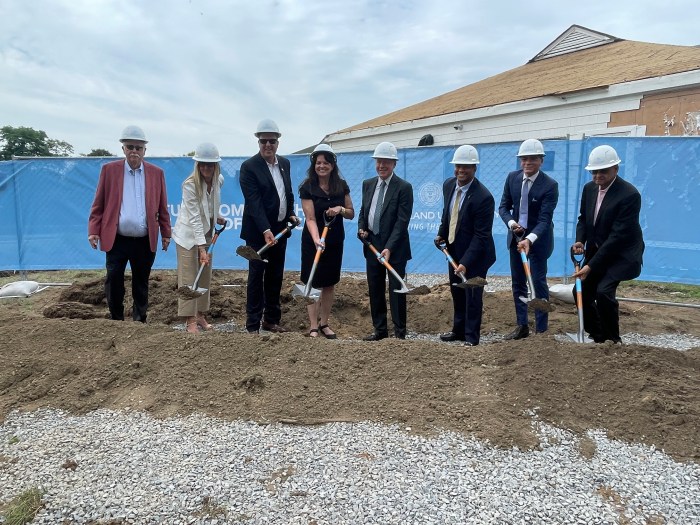Self-care for healing stress and burnout

(Photo by Breathe For Change)
Since returning to in-person learning after the pandemic, schools all over the United States have seen challenges resulting from students’ time away from the classroom. Eighty-seven percent of public schools reported that the COVID-19 pandemic has negatively impacted student socio-emotional development during the 2021–22 school year, according to the National Center for Education Statistics. These issues range from behavioral problems, like disruptive behavior, to chronic absenteeism, to learning losses. One of the ways to combat these problems is equipping staff and teachers with tools to support themselves, and thereby better support their students.
Shelter Rock Elementary School recently underwent a training initiative with Breathe For Change, a company that has been offering mindfulness and yoga training since 2015. Said Principal Richard Roder in a written statement: “At Shelter Rock, we developed a new partnership this year with Breathe for Change, in order to support “self-care” among our entire staff. Breathe for Change facilitates mind-body and social-emotional wellness trainings that unite, train, and support educators in enhancing individual and collective well-being. The “Breathe for Change” initiative was one approach explored at Shelter Rock to further support staff’s overall well-being. Staff engaged in seven after-school sessions throughout the year which included activities and exercises that focused on wellness.”
Ilana Nankin, founder of Breathe For Change, started the company using the results of her PhD research. “(this research) revealed how universal the issue of educator stress and burnout truly is and how powerful these mindfulness SEL and yoga practices can truly be for educators and students lives.” Nankin said.

Breathe For Change’s signature offering is their 200 hour training, now in its eighth year. This program used to be in-person, has been conducted via Zoom since the Pandemic. There are four major outcomes of this 200-hour training. Firstly, the educators’ physical, mental, and social well-being is enhanced through creating a personal well-being practice. Second, upon completion of the training, each educator qualifies as a certified yoga instructor. Third, they become leaders in social and emotional learning by being able to put their training into practice. Finally, they connect with a worldwide community of other educators who care about using wellness as a vehicle for healing and social change. According to Nankin, “We’ve graduated over 10,000 educators through our training, who are now doing remarkable work in their schools and districts, truly enhancing educator and student well-being.”
The benefits of Breathe For Change training can extend beyond the educator and into their classroom. Staff return to their schools equipped with tangible tools they can implement to help students learn to deal with their feelings. “They’re learning how to develop their students’ self-awareness skills, self-management, relationship skills, social awareness and responsible decision-making skills. They’re learning how to settle their students…and they’re learning how to effectively transition their students from one thing to the next. They’re learning how to effectively close out activities, with an appreciation circle or two word check in,” Said Nankin.
When it comes to the impact this has in the classroom, the hope is that it translates into a more holistic approach to teaching. Educators are able to translate what they’ve learned about caring for themselves into helping the students. “Their whole pedagogy is shifting right? They’re no longer just teaching the content that they need to teach to meet standards and ensure their students are successful academically, but they’re incorporating these social emotional learning and mind body wellness strategies into their instruction.”
These practices can be translated directly into results, especially when it comes to addressing the lingering issues of quarantines and lockdowns. Educators are better able to connect with their students after completing the training, because their own needs are being met. “We’re seeing huge reductions in behavioral issues, which clearly is an even bigger problem since COVID. We’re seeing increases in attendance rates, we’re seeing improvements in student academic outcomes, and educators are so much happier and more fulfilled in their roles.” Nankin said.

(Photo by Breathe For Change)
Nankin recommends selfcare as a first step for overall wellbeing, rather than an afterthought. “When we take care of ourselves, all of our intentions around our work and our parenting and our teaching exponentially improve. And there’s this weird switch that needs to happen where we recognize like self-care is not selfish. And then when our cups are filled up, we have way more capacity to show up in the way that we want to take care of you. if everyone was living this, we would be living in a peaceful and socially just world.”
These strategies are useful outside of the classroom as well. It’s something that anyone can understand. Nankin related a story about one of the students she taught as a preschool teacher, and his words of wisdom about well-being. “I’m a former pre-K teacher. one of my former students, Patrick, said, ‘you know, in a community, first you have to love yourself, because if you don’t love yourself, you can’t love anybody else.’”


































